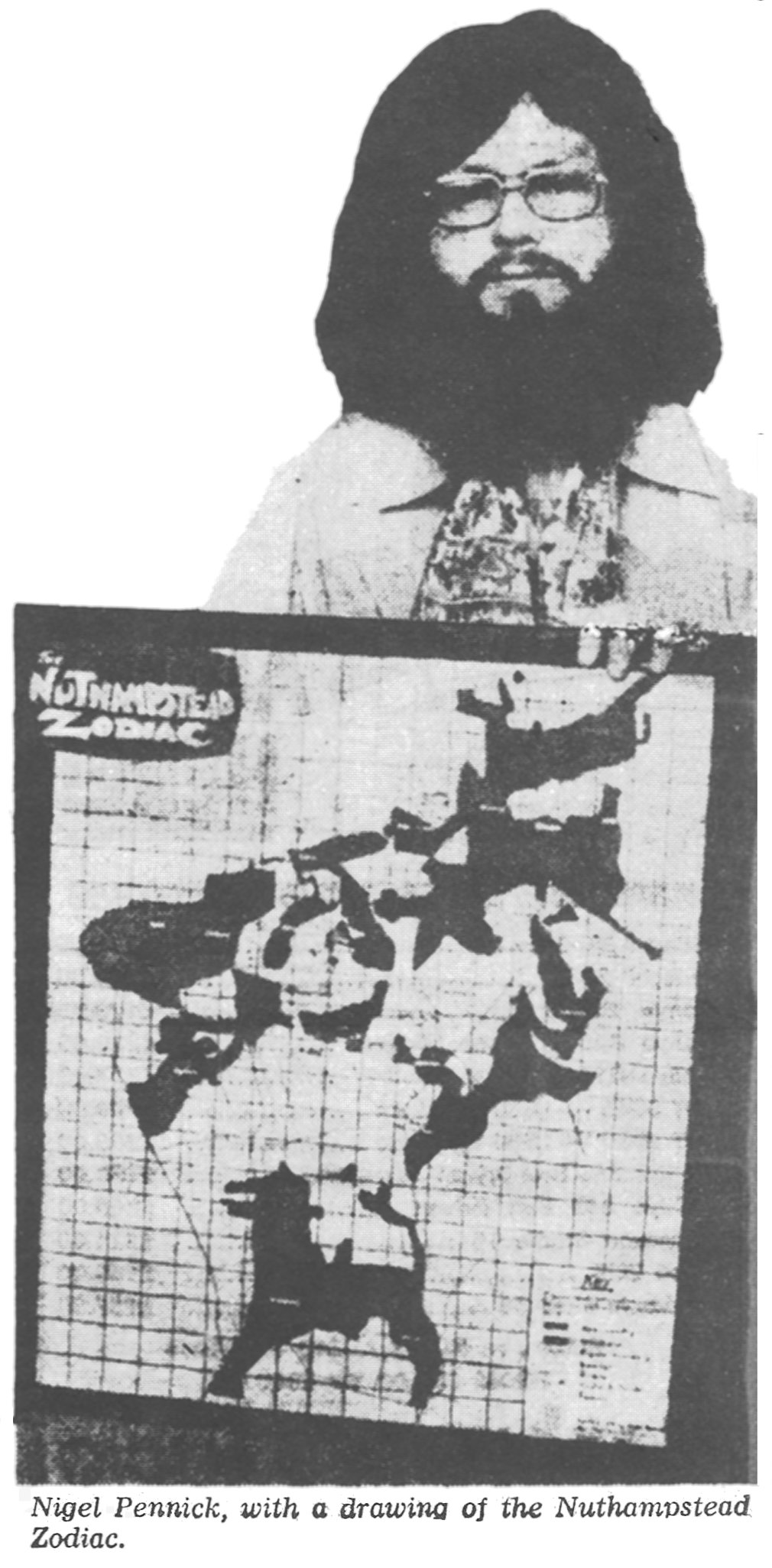
Journal of Geomancy vol. 1 no. 2, January 1977
From the Cambridge Evening News, Friday, December 10, 1976.
Reproduced in the Journal of Geomancy as artwork facing page 43.
TODAY’S NEWS
A small band of researchers have started to unravel the mysteries of a man-built phenomenon—the signs of the zodiac.
On Page 15 Dan Jackson writes about the work of the Institute of Geomantic Research.
ARKESDEN people have built their houses on the body of Scorpio; Great Chishill is part of the head of Capricorn; the hamlet of Stickling Green is on the hem of the skirt of Virgo.
For, displayed in the fields, woods, ditches and lanes of this corner of Essex, Hertfordshire and Cambridgeshire is a man-built phenomenon—the signs of the zodiac.
This is known as the Nuthampstead Zodiac. There is another at Glastonbury and yet another, newly-discovered at Pendle, Lancashire.
The Essex one was discovered by a small band of researchers based at Bar Hill. But these are no grant-cushioned, university-cosseted eggheads. Quite the reverse. They are outcasts of modern orthodox archaeology—the hardcore of the Institute of Geomantic Research.
Geomancy is the very ancient art of divining centres of energy on the earth’s surface, but the institute’s work extends further than this.
They are interested in terrestrial geometry, aligned sites, ley-lines, the geometry of sacred buildings, discovery of prehistoric trackways, turf-cut mazes, ancient stones and megaliths. In fact, anything which is ancient and unexplained interests them.
Mainspring of the organisation is Mr Nigel Pennick, a micro-biologist. In his 30s, with a black mane and shaggy beard, he is intense, keyed up with enthusiasm.
He spends hours, days, poring over old references, histories and plans of buildings like Ely Cathedral, King’s College Chapel, and Glastonbury, compiling and collating every scrap of fact, every hint of folklore, every minute measurement.
Mr Michael Behrend, a chemist who lives Girton, is the mathematician of the group. His speciality is landscape geometry. He applies precise mathematical analysis to show that Britain is planned on a triangulation system combining technical precision and mathematical ingenuity on a scale not hitherto even hinted at.
He suggests sacred sites were arranged according to a grand overall plan.
Prudence Jones is a truck driver who can translate medieval Latin. Her work takes her out and about and she can pursue her present exercise—to see if there is any relationship or meaning among certain churches in East Anglia. She is looking at churches with a round tower surmounted by an an octagon.
Mr Pennick’s wife, Ann, types the institute’s leaflets and pamphlets and also manages to investigate ancient tunnels.
Another Cambridge micro-biologist, Mr John Cann, is more concerned with the local history aspect and is currently working on plans and remains of Barnwell Priory, off Newmarket Road, Cambridge.
They formed their institute just over a year ago and have about 60 members, including some in Hong Kong and in America. The output from the group is remarkable. They produce a quarterly journal and numerous specialised occasional papers, all largely original work.
Their major publication, to be released within a few weeks, details the Nuthampstead Zodiac and also the Pendle Zodiac. They know that it will be shot down by big guns of archaeology, historians, churchmen, scientists. They are used to it now but they also know that not all the information will disappear in flames.
It will generate comment, jog memories and perhaps lead to more information being fed to them, so they can add another piece to the infinite jigsaw on which they are working.
“This is what we want,” said Mr Pennick. “More people to be aware of us and to pass on to us any information which may be of use. We see ourselves as researchers and collators of information. We need facts and we need to know quickly as early landscape is rapidly disappearing.”
Cambridge people will be able to judge for themselves the group’s validity, when, in the New Year, the institute will publish “The Geomancy of Cambridge.” It will include some startling information about King’s College Chapel and other sacred sites in the city.
But while the institute’s work may be scorned by some, their pioneer research will be useful to local historians today, and perhaps invaluable to historians tomorrow, when the only sacred buildings standing on their original sites will be cathedrals, and stone circles.

Editorial note in the Journal of Geomancy
Note: The Nuthampstead Zodiac was actually discovered by Nigel Pennick in 1969. The first full account of this geomantic construction has just been published by the I.G.R., titled “Terrestrial Zodiacs in Britain – Nuthampstead Zodiac and Pendle Zodiac”, available from the Institute.